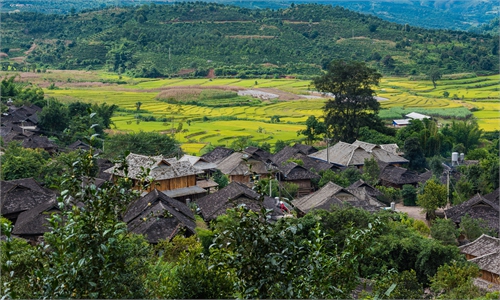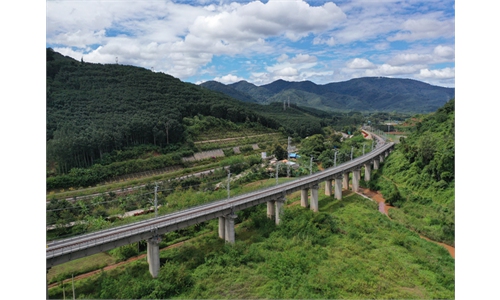COMMENTS / EXPERT ASSESSMENT
Vilifying China-Laos railway exposes West’s ‘sour grapes’ thinking

Illustration: Tang Tengfei/GT
With the China-Laos railway officially put into use, the Laotian people are now expecting more visitors after the country reopens its borders to fully vaccinated tourists in January 2022. Holding a sour-grapes mentality, Western media outlets, again, took the chance to hype up the baseless "debt trap" stories.
Citing so-called experts, Voice of America (VOA) said that Laos may become mired in a debt crisis due to financing from China to build the railway, and even with the railway being launched, exports of its agricultural and mineral products will be hard to be promoted.
It is simply another typical case reviewing the sour-grapes mentality of the US-led Western world, unwilling to see any beneficial cooperation between China and others, and they know clearly that they have lost advantages in pursuing such kinds of collaboration.
From the perspective of a landlocked country like Laos, the significance of setting up high-speed rail connections with its neighbors is clear for all to see. Before the completion of the China-Laos railway, the country only had a 3.5-kilometer long rail which links with Thailand, and transportation facility shortage was one major restriction inhibiting its economic growth.
The 1,035-kilometer China-Laos railway does not only connect Laos with China, but also linked the landlocked country with the international logistic systems, including the China-Europe freight trains that have linked China with 174 cities in 23 European countries now.
Since the China-Laos railway's inauguration on December 3, the total value of cargo transported by the railway exceeded 100 million yuan ($15.7 million) in just 12 days, according to the People's Daily.
Major imports of China through the railway are natural rubber, fertilizer, iron ore and others; and major exports from China are vegetables, fruits, steel products and electro-mechanical products. On Monday, a train carrying 21 cold chain containers of fruits and vegetables departed from China's Yuxi city to Laos' Vientiane, marking the establishment of a cold chain logistic channel between the two friendly countries.
It is not hard to assess the promising outlook of the railway and how it will boost Laos' economic cooperation with China, as well as with other neighboring countries, including Thailand, Cambodia and Vietnam.
The other crucial significance is that the railway linkage has demonstrated the trend of regional economies enhancing interconnectivity. Under the BRI framework, countries and regions have inked over 2,000 cooperative projects, which have offered the best answer for whether cooperating with China is beneficial or risky.
It is not saying that all projects will go smoothly without any setbacks, but the West will not pass any chance to tell the "debt trap" story again and again, even though the effect has been diminishing.
Frankly speaking, cross border transport connection projects usually take massive investments and come with longer return cycles. It takes elaborate planning and continuous maintenances, and be in the red in short term is common, especially in the early stages of project operation.
This is exactly one of the major reasons why the US and other Western developed nations unable to outcompete China in delivering such projects. Their capital seeks the shortest return cycles, and more importantly, the real goal behind their vilification of BRI is to contain the growth of China.
Laos and other nations cooperating with China know clearly which path delivers real benefits to them and will not be manipulated by the lies or rhetoric cooked up by the US and its allies. Instead of keep attempting to drive a wedge between China and others, the West may do better to come up with real plans to help the growth of the developing nations.
The author is an editor with the Global Times. bizopinion@globaltimes.com.cn



